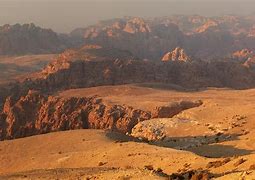I’ve done downward dog in some strange places: from a Tibetan monastery to the deck of a boat drifting down the Amazon River. None compare, though, to the sun-roasted rocks of Little Petra – or Siq al-Barid (“the cold canyon”) – whose Unesco-listed sandstone canyon walls are carved with the same ancient Nabataean buildings found at Petra
“Jordan has a unique energy,” says our yoga teacher, Sandra Jelly, as we scamper behind the Seven Wonders Camp where we’re staying. A jangle of jewellery and tight grey curls, she gave up her career in advertising eight years ago to move from Amsterdam. Now, she offers yoga and “horse meditation” classes (see below) to travellers who want to reconnect with the country’s ancient spirit and themselves.
Although seated between Syria, Israel, Iraq and Saudi Arabia, Jordan is an oasis of peace in a noisy neighbourhood. It’s not only safe and easy to enter (with a visa on arrival), but it has a quirky array of activities found nowhere elsewhere in the Middle East, making it ideal for both families and adventurous travellers.
Clambering over the boulders, I spy a belt of ants conveying edible morsels to their nest and a herd of goats nibbling nervously at the spiny scrub, eyeing us, bemused, as we stroll by with yoga mats sausaged under our arms.
Reaching the summit, we fuss like chickens to find a flat surface on which to unroll our mats until eventually we’re splayed in a higgledy-piggledy semicircle. Initially, it’s hard to find our balance on the knobbly rocks and we wobble like toddlers between the poses.
The setting sun soaks us in honeyed light, hazing the horizon. The breeze – warm as a hairdryer – blows in our faces, carrying the bleats of the goats and the imam’s evening call to prayer that echoes from the village mosque.
As we move through the asanas, I place my palm on the sandpapery surface of the stones and think of the hands that carved these temples, dwellings and market spaces more than 2,000 years ago. Of the Silk Road merchants that passed through these canyons, trading their wares, and of the generations of Bedouin who have called these caves home.
By the time we’re finishing up, stars glint above us. “Now, for the best bit,” winks Jelly. “Lie back in savasana.” I spread out on my mat, the heat of the stone beaming into my back, the wash of the night sky above me. Suddenly, the experience isn’t so quirky, but rather wonderful.
We pick our way back by torchlight, past the still toing and froing ants and the munching goats. The cliffs surrounding the camp are aglow from a hundred light bulbs hidden among the nooks – our own galaxy amid the stones of Little Petra.
Take your namaste to the next level and try horse meditation. A version of equine-assisted therapy, the horses respond to your inner feelings – rearing if you hold anger, for example – and are said to help to heal subconscious behaviour.
Unesco-listed Wadi Rum – also known as the “Valley of the Moon” – is unblemished by light pollution and offers out-of-this-world views of our galaxy. Snuggle up inside the see-through ensuite bubble domes at Wadi Rum Luxury Camp, whose covers are peeled back at night to reveal 360-degree views of the night sky, so you can scan for satellites and shooting stars from the comfort of a four-poster bed.
Spend time with the Bedouin – the original desert-dwelling nomads of the Arabian Peninsula. They’ll teach you desert survival skills, let you camp overnight with their family, teach you how to identify which plants can be used as lipsticks or soap and how to herd goats.
Ride Dead to Red
Embark on a nine-day cycling adventure from the Dead Sea – the lowest point on earth – to the Red Sea in the south, passing canyons, Crusader fortresses and the rose-red city of Petra. Distances range from 55-100km per day and you’ll be bedding down in hotels, a homestay, and a Bedouin camp.
Don your swimming costume for a day exploring Wadi Mujib – a spectacular canyon that also happens to be the world’s lowest nature reserve. Believed to be the biblical River Arnon, this water-filled ravine is a water stopover for migratory birds and there’s a chance of spotting Syrian wolf and Nubian ibex. But it’s the delicate play of light on the soaring rose-hued walls that you’ll remember forever.

